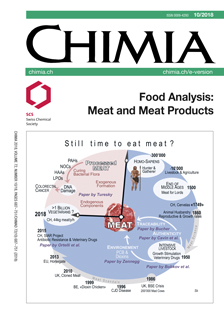Meat Vulnerabilities to Economic Food Adulteration Require New Analytical Solutions
DOI:
https://doi.org/10.2533/chimia.2018.697Keywords:
Economic food adulteration, Food fraud, Meat, Next generation sequencing (ngs), Rapid evaporative ionization mass spectrometry (reims)Abstract
Meat has been identified as one of the food categories at most risk of food fraud. Meat species substitution has been in the spotlight with the European horse meat scandal in 2013. Analysis of cases reported on the web shows that incidents of meat substitution are still recurring worldwide. Altogether these cases highlight significant weaknesses in the supply chain transparency and traceability of raw meat materials. This has triggered recent progress from the food industry to apply new software tools enabling the mapping of meat supply chains. Nevertheless, a meat vulnerability assessment showed that meat and derivatives are highly susceptible to many fraudulent malpractices. Therefore, more effective measures are needed to manage the risk and new analytical solutions are required to increase the deterrence of meat adulteration and rapid detection of fraud. DNA-based methods have evolved rapidly as shown with the application of the new LCD array and Next Generation Sequencing (NGS) in order to detect broad meat species adulteration. Moreover, new technologies such as NGS together with the Rapid Evaporative Ionization Mass Spectrometry (REIMS) are emerging as a really promising association of analytical approaches for rapid detection of several malpractices.Downloads
Published
2018-10-31
Issue
Section
Scientific Articles
License
Copyright (c) 2018 Swiss Chemical Society

This work is licensed under a Creative Commons Attribution-NonCommercial 4.0 International License.
How to Cite
[1]
C. Cavin, G. Cottenet, K. M. Cooper, P. Zbinden, Chimia 2018, 72, 697, DOI: 10.2533/chimia.2018.697.







